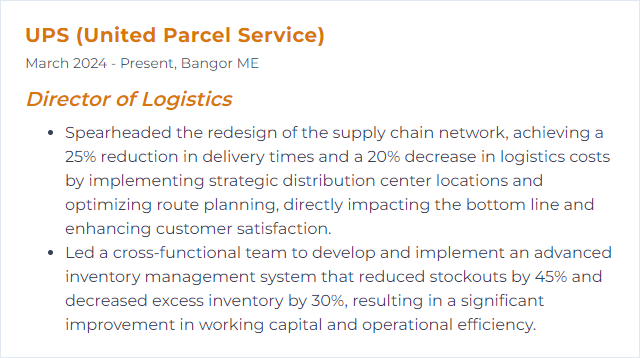Top 12 Director of Logistics Skills to Put on Your Resume
In today’s unruly job market, a Director of Logistics has to prove both brains and backbone—strategic thinking welded to ground-level execution. The right mix of skills turns chaos into cadence, streamlining supply chains, lowering costs, and keeping promises to customers without flinching.
Director of Logistics Skills
- SAP SCM
- Oracle Logistics
- Inventory Optimization
- Demand Forecasting
- Transportation Management
- Warehouse Management
- Supply Chain Analytics
- Lean Six Sigma
- Global Logistics
- Risk Management
- ERP Systems
- Continuous Improvement
1. SAP SCM
SAP SCM (Supply Chain Management) spans planning and execution across procurement, manufacturing, logistics, and fulfillment—now commonly anchored by SAP S/4HANA, SAP Integrated Business Planning (IBP), SAP Transportation Management (TM), and SAP Extended Warehouse Management (EWM). It aligns material, information, and financial flows to drive speed, accuracy, and reliability.
Why It's Important
It connects planning with action in real time, trims waste, improves service levels, and turns data into decisions fast. For a logistics leader, that means fewer surprises and steadier outcomes.
How to Improve SAP SCM Skills
Tighten the system; sharpen the team; raise the signal, lower the noise.
Adopt real-time architecture: Move to S/4HANA for in-memory speed, unified data, and cleaner processes.
Elevate planning: Deploy IBP for demand, supply, and inventory planning with scenario modeling and consensus planning.
Deepen logistics modules: Expand TM and EWM footprints for carrier selection, freight rating, slotting, yard, and automation integration.
Exploit analytics: Use SAP Analytics Cloud for KPI boards, exception alerts, and predictive insights.
Strengthen collaboration: Connect with suppliers via Ariba and standardize onboarding, scorecards, and compliance.
Instrument the network: Feed IoT telemetry from assets, fleets, and warehouses for live visibility and faster response.
Upskill relentlessly: Establish role-based training, centers of excellence, and release-readiness routines.
Iterate, measure, and harden processes with clear ownership and SLAs.
How to Display SAP SCM Skills on Your Resume

2. Oracle Logistics
Oracle Fusion Cloud Logistics brings transportation, global trade, and warehousing into one cloud backbone—pairing execution with planning, compliance, and cost control across regions and modes.
Why It's Important
It compresses lead times, clarifies costs, and boosts reliability. A single pane of glass for carriers, customs, and warehouses keeps decisions aligned and outcomes consistent.
How to Improve Oracle Logistics Skills
Close gaps between data, processes, and partners.
Integrate end to end: Connect ERP, order management, finance, WMS, and TMS so orders, rates, and events flow without rework.
Tune processes: Standardize tendering, appointment scheduling, freight audit, and claims with workflow automation.
Use analytics: Build dashboards for lane performance, dwell time, accessorials, and on-time metrics; act on exceptions, not noise.
Invest in people: Certify super-users, run scenario drills, and enforce change management playbooks.
Leverage experts: Engage specialized partners for rapid configuration, rates programs, and trade compliance rules.
Refine quarterly; benchmark against targets; retire legacy workarounds.
How to Display Oracle Logistics Skills on Your Resume
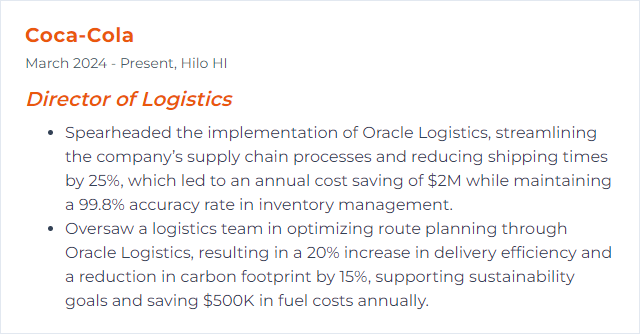
3. Inventory Optimization
Inventory optimization balances service, cost, and risk—setting the right levels, in the right locations, at the right time. It blends demand signals, variability, lead times, and constraints to curb stockouts and excess simultaneously.
Why It's Important
Because cash stuck on shelves can’t serve customers, and empty shelves lose them. Precision here pays twice.
How to Improve Inventory Optimization Skills
Make policy design a discipline, not a guess.
Forecast with rigor: Use statistical and machine learning methods, seasonality modeling, and probabilistic forecasts.
Segment aggressively: Apply ABC/XYZ to separate high-value, volatile, and stable items; set policies per segment.
Right-size buffers: Calculate safety stock using service targets and variability, not gut feel; review monthly.
Shorten and stabilize lead times: Collaborate with suppliers on schedule adherence and expedite rules; dual-source where prudent.
Synchronize network: Use multi-echelon optimization when stocking across plants, DCs, and stores.
Tighten master data: Keep lead times, MOQ, pack sizes, and yields current; small errors snowball.
Train the team: Build capability in inventory math, scenario testing, and KPI interpretation.
Track service, turns, days of inventory, and obsolescence together—never in isolation.
How to Display Inventory Optimization Skills on Your Resume
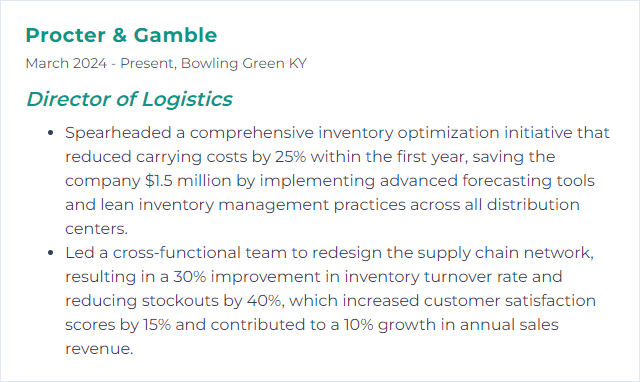
4. Demand Forecasting
Demand forecasting estimates future demand to steer purchasing, production, and distribution. Done well, it links market signals to operational reality.
Why It's Important
It prevents whiplash—too much or too little—while guiding capacity, cash, and commitments.
How to Improve Demand Forecasting Skills
Blend math, market sense, and governance.
Use ensembles: Combine statistical, ML, and causal methods; pick winners by horizon and product life cycle.
Feed real-time signals: Layer in POS, promotions, pricing, events, and weather where relevant.
Clean the data: Remove outliers, reconcile hierarchies, and maintain a single calendar of events.
Collaborate cross-functionally: Run a disciplined S&OP/IBP process with sales, finance, and supply.
Scenario plan: Model upside/downside and lead-time risk; predefine playbooks.
Measure accuracy the right way: Use weighted MAPE, forecast value add, and bias; learn and adjust monthly.
Upskill analysts: Teach feature engineering, lifecycle modeling, and promotion-effect estimation.
Focus on decision-quality forecasts, not perfection.
How to Display Demand Forecasting Skills on Your Resume
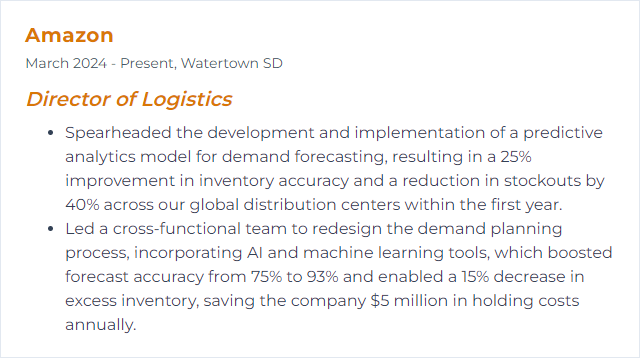
5. Transportation Management
Transportation Management plans, executes, and optimizes the movement of goods—mode selection, routing, carrier management, cost control, visibility, the whole chain of custody.
Why It's Important
Because on time and in full is table stakes. Do it cheaper, cleaner, and with fewer exceptions—and you win.
How to Improve Transportation Management Skills
Turn the network into a living system.
Deploy a robust TMS: Optimize routing, tendering, and settlement; automate audit and pay; enforce compliance.
Mine the data: Monitor on-time pickup/delivery, dwell, OTIF, claims, and accessorials; fix root causes, not symptoms.
Shape carrier strategy: Balance primary and backup carriers, run structured bids, and incentivize performance.
Go green with discipline: Consolidate loads, right-size equipment, and align with programs such as EPA SmartWay.
Harden risk controls: Diversify lanes and ports, use embargo playbooks, and pre-clear contingency routing.
Train the team: Elevate planners and dispatch with playbooks, simulation drills, and KPI ownership.
Enhance visibility: Real-time tracking, dynamic ETA, and automated exception alerts reduce fire drills.
Review quarterly by lane and mode; retire underperformers.
How to Display Transportation Management Skills on Your Resume
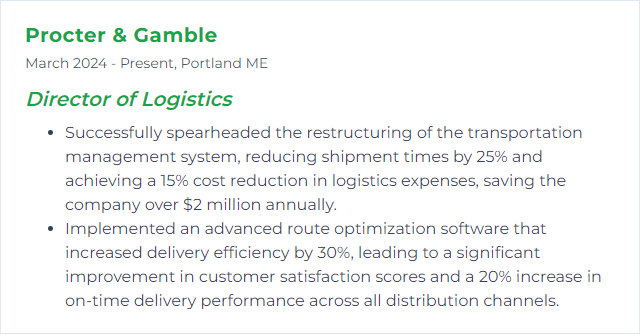
6. Warehouse Management
Warehouse Management governs inbound, putaway, storage, picking, packing, and outbound—plus safety and labor. It’s the heartbeat between inventory plans and customer promises.
Why It's Important
Accuracy up, cycle time down, cost per order under control. That trifecta shields margins and boosts satisfaction.
How to Improve Warehouse Management Skills
Simplify flows and kill friction.
Implement a capable WMS: Run a structured selection, pilot in a constrained area, then scale; standardize SOPs as you go.
Design for flow: Optimize layout, slotting, and travel paths; keep fast-movers close and heavy lines ergonomic.
Lean the operation: Remove non-value work, reduce touches, and embrace just-in-time where sensible.
Automate wisely: Consider AMRs, goods-to-person, dimensioners, and pick-to-light; prove ROI with phased deployments.
Elevate safety and training: Regular refreshers, clear signage, and certified equipment use; safety is speed.
Instrument performance: Track pick rates, dock-to-stock, inventory accuracy, and order cycle time; act on exceptions daily.
Consistency beats heroics—document, train, audit, repeat.
How to Display Warehouse Management Skills on Your Resume
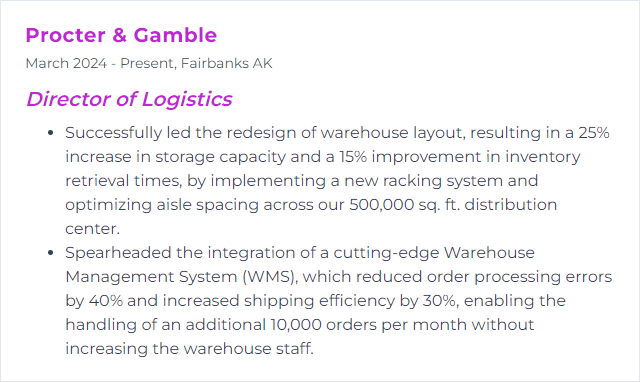
7. Supply Chain Analytics
Supply Chain Analytics transforms raw data into operational foresight—diagnostic, predictive, and prescriptive. From control towers to granular KPIs, it turns variability into manageable, visible work.
Why It's Important
Better decisions, faster. Lower cost, higher service. It’s the multiplier on every other capability.
How to Improve Supply Chain Analytics Skills
Make data trustworthy, timely, and useful.
Unify data: Integrate orders, inventory, transportation, production, and supplier feeds into a common model.
Raise data quality: Standardize codes, cleanse master data, and enforce governance owners.
Build the right dashboards: Role-based views with alerts for exceptions; drill from network KPIs to transaction detail.
Apply advanced methods: Use forecasting, optimization, anomaly detection, and simulation to guide actions.
Exploit IoT signals: Temperature, location, and equipment status improve traceability and proactive responses.
Upskill teams: Train on BI tools, statistics, and storytelling; insights must land with operators.
Close the loop: Tie analytics to SOPs so decisions trigger workflows, not just reports.
Measure the impact: fewer expedites, less inventory, and faster cycle times.
How to Display Supply Chain Analytics Skills on Your Resume

8. Lean Six Sigma
Lean trims waste; Six Sigma crushes variation. Together they deliver stable, faster, cheaper processes—ideal for logistics where flow and precision must coexist.
Why It's Important
It makes performance predictable and scalable. Less firefighting, more throughput.
How to Improve Lean Six Sigma Skills
Make continuous improvement relentless and visible.
Get the data right: Define CTQs, map value streams, and use control charts to spot drift early.
Invest in capability: Train belts across functions; certify project leads; coach for results, not rituals.
Break silos: Cross-functional kaizen events solve handoff pain where most waste hides.
Blend with agile: Short iterations, quick tests, tight feedback loops—speed without sloppiness.
Prioritize customer value: Improve what customers actually feel—lead time, accuracy, communication.
Reward improvement: Recognize wins publicly; track savings and service gains; keep a visible pipeline of projects.
Sustain with control plans and standard work—then raise the bar again.
How to Display Lean Six Sigma Skills on Your Resume
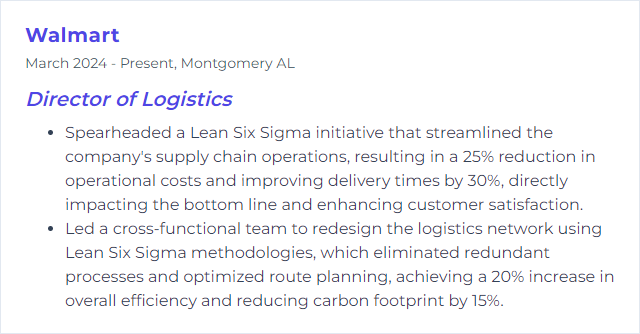
9. Global Logistics
Global logistics orchestrates cross-border movement, storage, compliance, and delivery—multiple modes, currencies, and regulations stitched together without seams.
Why It's Important
It expands market reach while controlling risk and cost. Done right, distance stops being the enemy.
How to Improve Global Logistics Skills
Design for resilience and transparency.
Digitize the chain: Real-time tracking, document digitization, and event management reduce blind spots.
Optimize routes dynamically: Reroute around congestion, weather, and geopolitical constraints with updated ETAs.
Strengthen supplier collaboration: Share forecasts, capacity plans, and scorecards; align on buffers and priorities.
Build sustainability into operations: Smarter packaging, modal shifts, and load density improvements cut emissions and cost.
Stay trade-compliant: Maintain master data for HS codes, origin, and restricted parties; audit often.
Train for complexity: Equip teams on Incoterms, customs regimes, and documentary accuracy.
Audit and adapt: Quarterly risk reviews across lanes, ports, and partners keep you ahead of change.
Redundancy in routes and suppliers is not waste; it’s insurance.
How to Display Global Logistics Skills on Your Resume

10. Risk Management
Risk Management identifies, evaluates, and mitigates threats to supply operations—from supplier failure and capacity shocks to cyber events and geopolitical shifts—while seizing upside when it appears.
Why It's Important
It keeps goods moving when the world tilts. Lower volatility, fewer disruptions, steadier margins.
How to Improve Risk Management Skills
Make risk work operational, not theoretical.
Map the risks: Build a live register across supply, logistics, systems, and compliance; rate impact and likelihood.
Analyze ruthlessly: Use scenario analysis and stress tests; quantify exposure and time to recover.
Mitigate with intent: Dual-source critical items, hold strategic stock, pre-contract alternates, and harden cybersecurity.
Monitor continuously: Track leading indicators—supplier health, port congestion, political signals, weather anomalies.
Communicate fast: Clear escalation paths, war rooms for major events, and pre-approved response playbooks.
Train and rehearse: Run tabletop exercises; document lessons learned; close gaps swiftly.
Review and improve: After-action reviews feed updated policies and KPIs; retire stale assumptions.
Resilience isn’t a project; it’s a posture.
How to Display Risk Management Skills on Your Resume
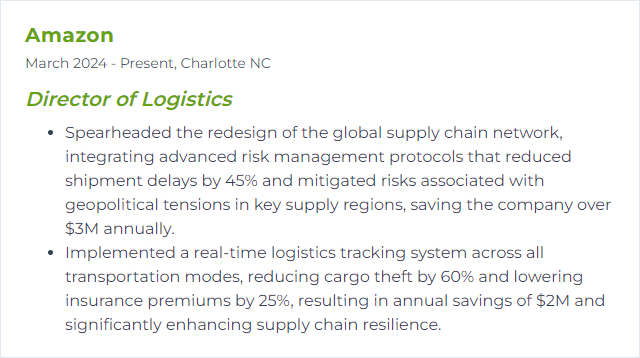
11. ERP Systems
ERP systems integrate finance, procurement, order-to-cash, manufacturing, and logistics into a single data backbone—reducing handoffs, reconciling truth, and accelerating execution.
Why It's Important
For logistics leaders, it means cleaner orders, better inventory accuracy, stronger visibility, and fewer unpleasant surprises between promise and ship.
How to Improve ERP Systems Skills
Tight coupling beats duct tape.
Integrate and automate: Connect ERP with WMS, TMS, CRM, and planning; automate routine transactions to cut errors.
Govern the data: Own master data quality, change controls, and catalog standards; bad data breaks good processes.
Enable real-time visibility: Event-driven updates for inventory and shipments; exception alerts, not after-the-fact reports.
Customize with restraint: Configure first; customize only for true competitive differentiation; document thoroughly.
Train and support: Role-based training, clear SOPs, and rapid help channels; adoption is everything.
Continuously improve: Align releases to business priorities; retire customizations as standard features mature.
Measure benefits: order cycle time, accuracy, and cost-to-serve.
How to Display ERP Systems Skills on Your Resume
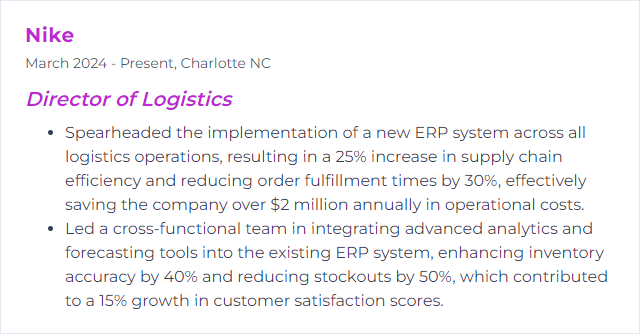
12. Continuous Improvement
Continuous Improvement is the drumbeat—small wins stacked relentlessly, with the occasional leap. Processes get simpler. Outcomes get steadier. Costs behave.
Why It's Important
It keeps operations nimble in a shifting world, protecting margin and service without constant reinvention.
How to Improve Continuous Improvement Skills
Turn CI from a slogan into muscle.
Set sharp goals: Use SMART targets tied to customer outcomes and financial impact.
Engage everyone: Frontline ideas, leadership air cover, and visible wins; ownership at all levels.
Lean logistics practices: Map value streams, remove waste, standardize best-known methods.
Leverage technology: Automate repetitive tasks, digitize workflows, and expose bottlenecks with real-time data.
Measure what matters: A crisp KPI set—service, cost, quality, speed—reviewed rhythmically.
Build learning loops: PDCA cycles, retrospectives, and A/B tests; institutionalize knowledge.
Refresh quarterly: Reprioritize the CI portfolio as conditions change; stop work that no longer pays.
Progress compounds. Keep it moving.
How to Display Continuous Improvement Skills on Your Resume
